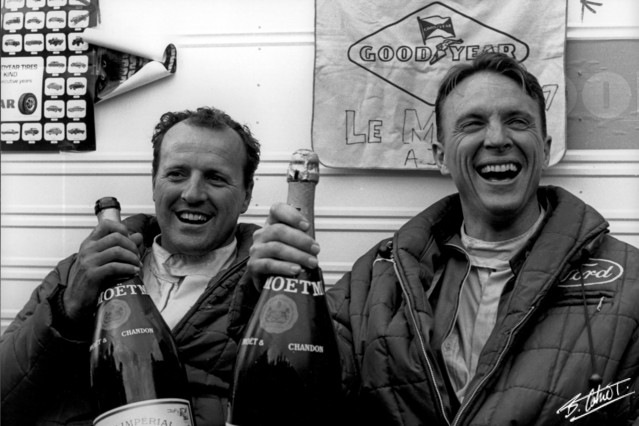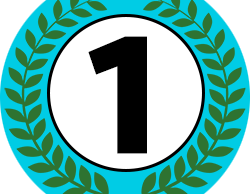
Champagne – it’s the stuff for those who make it to the top steps, and thanks to the gentleman on the right, wearing a little (or a lot) is as much a part of winning today as the checkered flag.
Meet Dan Gurney and A.J. Foyt – pictured above after their win at the 1967 LeMans 24 hour race. The two were rivals in Formula 1 and at Indy only to become teammates abroad in their Shelby-American Ford GT40 Mk. IV. The press at the time felt the two hard-charging drivers would let their rivalry spill over in the driver’s seat at the cost of getting their car to the finish, but all were proven wrong after they took the overall win over the Ferrari P3/4’s.
Normally after winning a race to this point, drivers would take a sip from the bottle or from their trophy cup – but on June 11, 1967, all that changed. In the crowd for the podium celebration were Henry Ford II and team principal Carroll Shelby – both of whom were part of the first baptism by bubbly – when Gurney took hold of the bottle and sprayed the crowd underneath.
The visibility champagne has had at a podium ceremony hasn’t diminished since, and there’s no sign of it slowing down . . .
Champagne’s history in F1 dates back to the first year of the championship in 1950, at the French GP in Reims in the heart of the growing region. Juan Manuel Fangio won, and racing fans Paul Chandon Moët and his cousin Count Frédéric Chandon de Brailles offered him a jeroboam of Moët et Chandon. F1 hasn’t looked back.
Way back then, Champagne was the podium beverage of choice, but bottles weren’t even opened on the podium. More recently, Champagne’s sponsorship of F1 hit a roadblock in native France, when the country’s ‘Loi Evan’ prohibited visible alcohol branding in media after 1993.
Reinforcing the drink’s role on the podium is a part of its image, but how could Champagne as a region maintain it’s luster in the country from which it came? Enter F1 – the luxury brand platform. With its rich history of celebrating with a bottle at the podium, F1 presented a television audience that knows what’s in the bottle, but may not be able to tell who made it. Worldwide, Champagne’s presence is reinforced by implication and television commentary – except today in some countries where a display of consumption of alcoholic beverages is prohibited by law.
Today, Champagne G H Mumm has partnered with Formula 1, and since 2000, it has afforded the brand a place in victory with each race win acting as a platform for Mumm to bring visibility and placement to their ultra-premium brands. Attaching the thrill of victory and the audience’s experience with winning a race or a championship to a product is the kind of placement a luxury or exclusive brand benefits from significantly.
As we look ahead to F1’s return to America, exploring synergies with different brands and placement around the 2012 Austin Grand Prix will be crucial to F1 creating and exploiting its niche in the United States, and legends like Dan Gurney and their stories only help to give a broader history America has had in F1. The opportunity to build on what America’s past and potential role is in the sport exists for fans and brands alike, and it’s now up to both America and F1 to create a landscape in which each can find ways to support the growth of Formula 1 in America.

